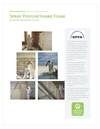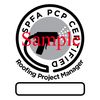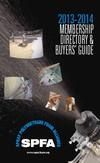RE: California Department of Toxic Substances Control Proposed Regulation of Chemicals Utilized in Spray Polyurethane Foam "for Home and Building Insulation, Weatherizing and Sealing, and Roofing"
In March 2014 the California Department of Toxic Substance Control announced three priority product areas that the state will focus upon for potential rulemakings, intended to limit or potentially ban the use of those products in the state. Spray polyurethane foam was identified as one Priority Product area. Spray Polyurethane Foam Alliance (SPFA) contends that this decision to include SPF was misguided, an over-reach, and based upon information utilized by California Department of Toxic Substances Control (DTSC) that was less than accurate as presented. SPFA recognizes that the state is a very important driver for reducing environmental footprints of products and buildings, and increasing building energy efficiency. Customers from home and commercial building owners to homebuilders and architects demand the use of SPF to reach the ever-increasing energy codes in the state due to its superior product performance. SPF is a safe product that delivers, and any efforts to limit or ban its use will be a great detriment to the customers in the state, as well as the many small professional businesses that install SPF, and will be met with significant opposition by SPFA.
With industry best practices and the safe and effective installation of spray foam representing two core missions of the organization, SPFA has consistently, openly and transparently collaborated with the U.S. Environmental Protection Agency (EPA), the Occupational Safety and Health Administration (OSHA), and the National Institute for Occupational Safety and Health (NIOSH) in the safe use of spray foam ingredients and systems over the past half-decade. While SPFA understands and emphasizes that the recent DTSC announcement is not a ban of spray polyurethane foam (or the use of diisocyanates found in a multitude of consumer products), it considers the announcement unfortunate as it undermines the desire among California private and professional customers for a safe and effective building product that delivers on performance.
California has demanded increased energy efficiency performance of homes and buildings in a way that few products other than spray foam can deliver, and simultaneously initiated efforts to regulate the product in a way that may render its performance impotent.
Read full statement here.
>>SPFA Testifies at All Three Recent California DTSC Public Workshops
SPFA testified at three hearings in California recently on the industry's behalf. All manufacturers, distributors, and California member contractors were encouraged to attend the hearing closest to them and communicate with the CA DTSC regarding inaccuracies in the Department's statement, and the negative impact upon SPF business in the state.
The Department initiated a new regulatory process in March 2014 under the new California Green Chemistry Initiative and the Safer Consumer Products law. The California Department of Toxic Substances Control (DTSC) reviewed over 1,500 products and constituent materials and selected a three initial priority products to work with. Spray polyurethane foam, or more specifically "Unreacted Diisocyanates in SPF" was one of the products selected. SPFA and the SPF industry have reached out to DTSC on many occasions to better understand the process of selection and what the Department is expecting from industry. SPFA and the American Chemistry Council have contended from the moment of the announcement that no outreach was performed by the Department to the industry. SPFA further contends that this lack of outreach resulted in a failed selection process that still lacks open explanation, in critical misunderstanding of SPF systems among the Department staff, erroneous conclusions drawn from cited research studies, lack of citations to studies such as those published from the US government’s Center for Disease Control (CDC) and California’s own Department of Health that directly conflict with the DTSC’s basis for determination, likely duplication around Isocyanates programs already ongoing, such as the EPA’s Chemical Action Plan (CAP) on Isocyanates, and OSHA’s National Emphasis Program (NEP) on Isocyanates (in which CalOSHA participates), and a published Priority Product Profile available on the DTSC’s website still today that delivers factually incorrect information.
"Members have indicated in public testimony that the Department’s mishandling of the process and information, and resulting perception among customers of uncertainty for the product’s future in California, have resulted in immediate material negative impact to their businesses. Manufacturers have reported hearing questions regarding DTSC action in states as far away as New York and Texas thanks to the mainstream media’s coverage of this debacle. And the homebuilding industry in California, a big proponent of SPF, suggests that their advanced purchasing decisions have been thrown into uncertainty because of the confusion around SPF resulting from DTSC’s handling, just at the time when preparations are being made to comply with 2016 high efficiency Title 24 California energy codes," said SPFA Executive Director Kurt Riesenberg. "It’s like being locked in a house with both the heat and air conditioning running at the same time, when these different state agencies are actually working against each other’s internal interests."
The DTSC has listened to the concerns of the industry, but have provided little remedy in the way of correcting bad information on their website. SPFA, the American Chemistry Council, and a team of members spent almost an entire day with DTSC staff after the announcement educating them on SPF topics in the hopes of addressing concerns from an informed standpoint. "What is really unfortunate," continued Riesenberg, "is what we’ve said all along: this could have all been avoided if they had just asked us some questions before they surprised everyone with the announcement." SPFA has formally requested within the DTSC public workshops that the erroneous information contained in the Priority Product Profile document be removed from the DTSC website until corrections can be made, to avoid the continued spread of incorrect information. To date, DTSC has added a disclaimer within the document. SPFA and the California members anticipate working with DTSC and other state interests as this regulatory process continues unabated toward the next steps, including potential alternative assessments for SPF.
"While we are certain the DTSC is well intentioned in pursuing this new regulatory path available to them in California for the health, safety and well-being of their constituents, the guinea pig nature of our involvement and the complete failings we have seen to date by the state leave us with these unfortunate and serious allegations," said Riesenberg. "It is very difficult to accept the time, expense and ill-defined expectations of an alternative assessment when the process that led us to this point has been wrong, period."
For more details click here. For the full SPFA statement, click here.
>> SPFA to Elect New Board Members
This is an election year for the SPFA Board of Directors. The new Board of Directors will be seated on July 1, 2014 for their two-year term.
>> SPFA Finishes Environmental Product Declaration for SPF 
As a continuing step toward effective product and environmental stewardship, SPFA and Underwriters Laboratory Environment (ULe) conducted the necessary steps to complete an SPF Environmental Product Declaration (EPD), which further validates the 2012 release of the SPF Life Cycle Assessment (LCA). This Declaration, along with the LCA, are recognized by sustainability experts as additional verification of a product’s environmental performance. The EPD is maintained on the ULe website, available at www.sprayfoam.org/technical. The LCA is available there, as well.
|
Spray Polyurethane Foam Alliance (SPFA) has submitted on behalf of its membership formal comments to the California Department of Toxic Substances Control (DTSC) regarding the evaluation of spray polyurethane foam and the use of diisocyanates. As part of this official industry response provided June 30 to the DTSC, the SPFA highlights serious inaccuracies in the Department’s public documents about the product and the harm these inaccuracies have caused the industry in and out of the state of California.
"We urge the DTSC to correct the multiple inaccuracies in the documents put forth to the public regarding the use of diisocyanates in spray polyurethane foam," said Kurt Riesenberg, executive director of the SPFA. "These incorrect facts have caused irreparable harm to an industry that is unparalleled in its ability to achieve energy efficiency and serve the state of California in its net zero energy goals set forth by 2020."
The SPFA’s formal response lists multiple inaccuracies and prejudiced statements including: unsubstantiated assertions that diisocyanates in sprayfoam are attributable to leading causes of occupational asthma; the inappropriate assertion that alternatives to diisocyanates in sprayfoam should be used or considered prior to the completion of a formal evaluation; multiple inclusive references in the Department’s documents to TDI and HDI isocyanates, which are not components of spray polyurethane foam; the critical need for the DTSC to make distinctions between various types of SPF such as sealants, insulation and roofing, which represent different products, different installation environments, different chemical constituents and different hazard levels; the state’s duplication of existing federal EPA, NIOSH and OSHA efforts addressing diisocyanates installation safety; and SPFA’s continued disappointment throughout the process with DTSC’s failure to initially reach out to industry before publishing inaccurate information, and the subsequent failure of not correcting published information proven to be incorrect.
"The SPFA is concerned the DTSC’s efforts will continue to decimate jobs and energy efficiency in California," added Riesenberg. "At the very least, any and all information the Department puts forth during this evaluation process must be accurate and substantiated. It would be remiss for any public documents to be anything but factual yet that is the situation we find ourselves in."
Following the SPFA’s formal comments submission, the association will continue to actively participate in the DTSC Priority Products evaluation process. "The SPFA will be an active voice and participant in this process to protect our members, constituents, customers and affiliate industries in the state of California," added Riesenberg. "Spray polyurethane foam remains unmatched in performance as an insulation and roofing material and we will continue to showcase the immense product benefits and safety to the Department and public."
The next steps in the Department’s Priority Products evaluation process include public hearings, the establishment of the Final Priority Product List, an Alternatives Analysis and a Regulatory Response (which could range among a number of rules and regulations regarding the use of SPF in California).
Statements from industry stakeholders about the impact of the DTSC’s Priority Product effort relative to spray polyurethane foam:
"In order to prioritize a product, DTSC is required by law to demonstrate significant or widespread adverse impact. DTSC’s prioritization of SPF is based on isocyanates being the leading attributable cause of occupational asthma. Yet, according to the California Department of Public Health, out of 974,000 cases of occupational asthma, none have been attributed to SPF. Therefore, based on DTSC’s own data, the case against SPF fails."
Mitch Fine
CEO
Armstrong
"Sprayfoam is a safe product, performing a great service to the state of California by helping save energy. The Governor's goal of net zero energy by 2020 needs sprayfoam with its tremendous air-sealing properties and superior energy efficiency performance. Unfortunately, the inaccuracies in the DTSC's sprayfoam Product Priority Profile continues to cause harm and widespread confusion among consumers, builders and building owners. We ask the DTSC to correct the sprayfoam PPP immediately. Sprayfoam offers a proven solution to reducing global carbon dioxide emissions by reducing energy loss in buildings. We look forward to partnering with DTSC on responsible Green Chemistry initiatives, so that the state of California continues to enjoy the exceptional benefits of sprayfoam."
Will Lorenz
National Sales Manager
General Coatings
Fresno, CA
"The DTSC has done irrefutable harm to the spray polyurethane foam industry. I have built my business over the past 11 years and have experienced a serious loss in revenue due to the DTSC's current process and harmful, incorrect published product information. Several jobs on my books have been changed to other types of insulation. Two customers completely cancelled their projects with me. Numerous architects have shared that they cannot spec sprayfoam until the DTSC process has run its course. And one major builder recently informed me that an 8 subdivision project with planned sprayfoam insulation will now not use the product. This equates to a loss of $5-6 million to my business! If the DTSC evaluation process is not completed soon, or results in the regulation or ban of this incredibly effective and safe product, I will be out of business and forced to leave the state."
Gary Talbott
President
5 Star Performance Insulation, Inc.
|

>>Polyurethanes Conference Brings Back Popular Workshop on Environmental, Health and Safety
Source: americanchemistry.com
Attendees at the 2014 Polyurethanes Technical Conference can look forward to a pre-conference workshop on the environmental, health and safety (EHS) issues related to diisocyanates. Hosted by the Center for the Polyurethanes Industry (CPI) of the American Chemistry Council, the conference will take place from Sept. 22-24 at the Gaylord Texan Resort and Convention Center in Dallas.
"Attendees can look forward to gaining a deeper understanding of fundamental topics and ever-changing regulations related to the EHS issues surrounding diisocyanates, which are increasingly important for today’s polyurethane professionals," said Lee Salamone, senior director of CPI.
Titled "Introduction to Environmental, Health and Safety Issues Relative to Diisocyanates," the pre-conference workshop will be held on Sunday, Sept. 21 from 1-5 p.m. At the workshop, industry experts will discuss the fundamental concepts of EHS regulations, industrial hygiene, toxicology, medical surveillance and exposure controls.
>>Alternatives and Risk Reduction Approaches to Trichloroethylene (TCE) Use as a Degreaser
Source: epa.gov
On July 29-30, EPA will hold a public workshop on the use of trichloroethylene (TCE) as a degreaser, availability and efficacy of safer alternatives, and possible risk reduction approaches. The goal is to generate information from experts on TCE when used as a degreaser to better understand the risk reduction considerations when transitioning to safer alternatives and other cleaning strategies. These risk reduction approaches could be regulatory, non-regulatory, or a combination of both.
This workshop is being held to support risk reduction activities concerning the health risks from TCE exposures to consumers using spray aerosol degreasers and workers using TCE as a degreaser in small commercial shops identified in the final risk assessment that was released on June 25, 2014.
The workshop will be held at EPA Headquarters’ William Jefferson Clinton East Building, 1201 Constitution Avenue, Washington, D.C., and will also be available via webinar and conference line. For more information, or to register and participate in person, or to register and listen via webinar, visit: http://www.epa.gov/oppt/existingchemicals/
>> New-Home Sales Up 18.6 Percent in May
Source: nahb.org
Sales of newly built, single-family homes rose 18.6 percent to a seasonally adjusted annual rate of 504,000 units in May, according to newly released data by the U.S. Department of Housing and Urban Development and the U.S. Census Bureau. This is the highest rate since May 2008.
Regionally, new-home sales were up across the board. Sales rose 54.5 percent in the Northeast, 34 percent in the West, 14.2 percent in the South and 1.4 percent in the Midwest. The inventory of new homes for sale held steady at 189,000 units in May. This
is a 4.5-month supply at the current sales pace.
>>American Chemistry Council Publishes 2014 Comprehensive Economic Profile of $812 Billion Business of American Chemistry
Source: americanchemistry.com
The American Chemistry Council (ACC) issued its 2014 edition of the Guide to the Business of Chemistry, a detailed economic profile of the chemistry industry and its contributions to the U.S. and world economies. Prepared annually by ACC’s Economics and Statistics Department, The Guide to the Business of Chemistry divides the $812 billion business into more than 30 categories of production, ranging from inorganic chemicals to plastic resins; from adhesives and sealants to oilfield chemicals; and from fertilizers to pharmaceuticals and consumer products. Within each segment the report highlights distinct characteristics, including growth dynamics, markets, new developments, and other issues affecting each sector. Read more here.
>>ASHRAE bEQ Program Qualifies for Florida Rating System under Energy Bill
Source: ashrae.org
Under amended legislation recently signed, the building energy rating and labeling program known as Building Energy Quotient (bEQ) now qualifies as an energy rating option for buildings in the state of Florida.
Florida Governor Rick Scott signed House Bill 7147, which qualifies the bEQ program as an approved system, on Friday, June 13. The provisions in the bill amend a 2013 Florida law specifying requirements for energy ratings for all residential, commercial and state-owned buildings. Read more here. >>Update from the U.S. Department of Energy's Building America
Source: energy.gov
Topics addressed in the current newsletter include:
-A Top Innovation Spotlight on high-efficiency window air conditioners
-Apply for the 2014 Housing Innovation Awards by June 30
-Crafting effective building science power words
-June 25 webinar on deep energy retrofits
-Residential building success stories from Florida
-Upcoming DOE Zero Energy Ready webinars on marketing and sales solutions and building fortified homes
-The latest publications from Building America: multi-split heat pumps in multifamily retrofits, case studies for deep energy retrofits, and more!
Click here to access the newsletter.
>>Spray Foam Coalition Comments on California "Priority Products List" Workshops
Source: americanchemistry.com
The California Department of Toxic Substances Control’s (DTSC) Safer Consumer Products Program held public workshops to gather input on the initial Priority Products list before the official rulemaking process began.The Spray Foam Coalition, a self-funded group of the American Chemistry Council (ACC), released the following statement after the final workshop.
>>Deadline Extended to July 7 for DOE's Housing Innovation Awards
Source: energy.gov
Any registered builder who has certified a DOE Challenge Home or DOE Zero Energy Ready Home between April 1, 2013 and June 30, 2014 is eligible to compete in the Housing Innovation Awards. To ensure that all program partners have the opportunity to adjust to the new application process, the deadline for submissions has been extended one week to July 7, 2014.
The U.S. Department of Energy's Housing Innovation Awards recognize the very best in innovation on the path to zero energy ready homes. The 2014 Housing Innovation Awards ceremony will be held on September 23, 2014, at EEBA’s Excellence in Building Conference in St. Louis, MO.
>>Free Monthly Webinars with U.S. Dept. of Energy Building America Program
Source: energy.org
U.S. Department of Energy Building America program to present monthly webinars that will offer information about the latest advances in residential building technologies and practices. After registering, you will receive a confirmation email containing information on how to join the webinar.
June 25, noon-1:30 p.m. EDT
Part 1 of this series introduced the basic concepts of building and wind interactions and how the FORTIFIED building programs can reduce property damage and loss. In Part 2, IBHS will discuss the building systems that are most vulnerable and how getting the roof right can reduce as much as 50% of the $20 billion of insured property losses that homeowners experience each year in the United States.
June 25, 3 p.m. EDT
The webinar will focus on specific Building America projects and case studies that highlight real-world examples of deep energy retrofits (DERs) that are meeting with technical and market success. Presenters will focus on technical strategies, modeled and actual performance results, and project costs.
 >>Registration for Race to Zero Student Design Competition Opens Sept. 2 >>Registration for Race to Zero Student Design Competition Opens Sept. 2
Source: energy.gov
The Race to Zero is an annual competition, open to students and faculty from any interested collegiate institution in the U.S. and Canada. The competition is based upon a real-world scenario where a builder needs to update an existing product line (house plan) to a high-performance house design or is developing a new high performance home product line. Participants in the 2015 Race to Zero Student Design Competition will have the opportunity to provide creative solutions to real-world issues in our nation’s housing industry. Finalist teams will be invited to attend the competition’s judging day and present their proposals to a panel of judges at the National Renewable Energy Laboratory (NREL). The winning teams will be recognized at a national conference and the winning designs will be made available on the DOE’s Zero Energy Ready Homes website. Registration for the Race to Zero will open on September 2, 2014 and will be accessible via the Race to Zero website.
>>Register Now for BSC Seminar in September with Joseph Lstiburek
Source: buildingscienceseminars.com
The seminar "2014 Renovation and Rehabilitation" with Dr. Joseph Lstiburek will be taking place September 25, and there are still a few of the 15 spots available. The seminar is a highly personal "boardroom" discussion that will address the specifics of renovation and rehabilitation. It takes place in Westford, Massachusetts. To register or to see the reading material for the seminar, click here.
Lstiburek also hosts a Building Science Summer Camp each year. To see excerpts from the 2013 Building Science Summer Camp at Lstiburek's residence, click here.
|


If you have updates that you would like included in the 2014-15 SPFA Membership Directory and Buyers' Guide, be sure to contact SPFA by July 7! Or, if you have been procrastinating, NOW is the time to renew your membership or sign up as a new member so your company will be included in the directory.
To see membership benefits, click here. There are also application documents here for Contractors, Consultants and Suppliers.
For questions, contact Mickey Riesenberg at SPFA. To see last year's directory, click here.
|
The Summer 2014 issue of SPRAYFOAM Professional is complete and should be in your mailbox shortly. The digital version is has already been released. Some enhanced features in the digital version include:
>>Search for specific keywords or phrases.
>>Flag favorite articles.
>>Make notes in the margins.
>>Connect with vendors quickly and easily.
|

>>SPFA Publishes Membership Brochure
Available on the SPFA website, the brochure highlights some of the various benefits of membership and activities of the organization as it pursues its mission to represent SPF professionals in areas of technical and environmental leadership, government advocacy, professional certification, industry promotion and outreach, and delivery of a world-class convention and expo. Please check out the brochure if you have been considering joining SPFA and support our mission to serve you. For more information or to access the application to join, please click here.
>>Deadline to Be Part of SPFA Membership Directory and Buyers' Guide is July 7!
Members in good standing are listed in this publication, which is mailed out every September. This directory is also available in a digital format here. The convenient digital format allows users to navigate and access the directory's content quickly and easily, on the road or in the office. Use the information provided to contact fellow SPFA members and industry partners throughout the year to share ideas, ask questions, or just stay in touch.
To be part of the 2014 Directory, make sure you are a member in good standing as of July 7. Please contact Mickey Riesenberg at SPFA with questions.
>>SPFA Member Benefits
SPFA knows there are lots of organizations out there that would like to have you in their membership. But if you are in, or getting into, the sprayfoam business, we are the place for you. We work hard to represent you well and give you value back for your support. Click here to find out more.
 >>SprayFoam 2014 Coverage, Award Winners >>SprayFoam 2014 Coverage, Award WinnersIn addition to coverage of some of the SprayFoam 2014 sessions and events in the SPFA magazine, SPRAYFOAM Professional, there will be spotlights on some of the SPFA National Industry Excellence Award winners:
Commercial Wall Foam Winner: Domestic Insulation (See coverage in Summer 2014 issue.)
Commercial Wall Foam Runner-Up: Biofoam Inc.
Residential Wall Foam Winner: PROFOAM of Tennessee
Residential Wall Foam Runner-Up: Jag Construction Inc.
Roof Foam Less Than 40,000 sq. ft. Winner: PROFOAM of Tennessee
Roof Foam Less Than 40,000 sq. ft. Runner-Up: Honeywell Building Envelope Solutions
Roof Foam Greater Than 40,000 sq. ft. Winner: Arizona Foam & Spray (See coverage in Summer 2014 issue.)
Roof Foam Greater Than 40,000 sq. ft. Runner-Up: West Roofing Systems, Inc.
Specialty Applications Winner: West Roofing Systems, Inc.
Specialty Applications Runner-Up: Polyseal Insulation LLC
>>Break-Out Sessions
Speakers at the highest-attended break-out sessions will be summarizing some of their material in upcoming issues of SPRAYFOAM Professional.
(See more details on the session "OSHA Is at My Jobsite -- What Do I Do?" by Joseph E. Bolduc, MBA, CSP in the Summer 2014 issue.) Also, many of the slides from the presentations are available here.
|

>>Do You Need a Reason to Get Out of the Heat?
As the temperatures soar through most of the United States, SPF Contractors can make the most of their time to beat the heat. You can now take written exams online in the comfort of your office. You just need to block out 2 hours, get comfortable in front of your computer and take an SPFA PCP Written Exam and you’ll be on your way to achieving the prestigious SPFA PCP Certification. Do your spraying during the coolest parts of the day and when the temperature is at its peak, you can still be productive (but in the comfort of your office!).
You can also meet some of the other criteria for the different levels of certification through online sites. For example, the CPI Chemical Health and Safety Course is free and available online 24/7. Depending on the level of certification you are seeking, you may need either the OSHA 10 or OSHA 30-hour course for construction and these are available online also (for a fee).
>>PCP Certification Mark Available to SPFA Certified Individuals

If you are an SPFA PCP Certified Professional, you are among the first in the SPF industry to achieve this certification. We have a Certification Mark available for your use to help you promote this accomplishment. Simply contact our office at 866-222-5000 or email admin@spfapcp.org and we can send you your customized SPFA PCP Certification Mark to use on your business cards or in your professional correspondence. The Certification Mark that is on your ID card has been customized with your certification number. We can send you the same thing in a format that can be printed.
It is important to note that the Certification Mark may only be used by certified individuals for their own personal use. In other words, the mark cannot be printed on T-shirts and worn by your entire crew. It is only to be used by the person who earned the distinction. The terms and conditions of the use of the Certification Mark are defined in the Certification Agreement that all SPFA PCP Certified Professionals have signed.
>>SPFA PCP Exam Prep Courses and Exams
July 12 -- Spring, TX
Hosted by Bayer (private)
July 14-17 -- Marlborough, MA
Hosted by Lapolla
July 14-18 -- Houston, TX
Hosted by Lapolla
Sept. 15-19 -- Santa Fe Springs, CA
Hosted by Diamond Liners
October 14-16 -- Waukesha, WI
Hosted by Gaco Western
Contact Karen Wolfenberger at kwolfenberg@gaco.com
October 15-17 -- Houston, TX
Hosted by Lapolla
Contact Shana Rand at srand@lapolla.com
Ongoing -- Webinar SPFA PCP Refresher Courses for Previously Trained SPF Professional
Hosted by Gaco Western
Contact Karen Wolfenberger at kwolfenberger@gaco.com
More details for each location are available on our website – www.sprayfoam.org. If you would like more information on the PCP, please contact Kelly Marcavage, SPFA PCP Certification Director at kmarcavage@sprayfoam.org.
|

>>SBA Launches Growth Accelerator Fund, Deadline for Competition Is Aug. 2
Source: SBA.org
The U.S. Small Business Administration is launching a $2.5 million competition for accelerators and other entrepreneurial ecosystem models to compete for monetary prizes of $50,000 each to fund operating budgets. To award the prizes, applicants will be judged by an expert panel that will consider each applicant's stated mission, founding team members and business goals among other core components. The application deadline is August 2, 2014.
|
>>ASHRAE/IES Publish User’s Manual for Standard 90.1
Guidance on how to incorporate changes regarding building envelope, lighting, mechanical and the energy cost budget in the 2013 energy standard from ASHRAE and IES are included in a newly published User’s Manual. ANSI/ASHRAE/IES Standard 90.1-2013, Energy Standard for Buildings Except Low-Rise Residential Buildings, incorporates 110 addenda, reflecting changes made through the public review process.
>>DOE Issues Preliminary Determination of Energy Savings for ANSI/ASHRAE/IES Standard 90.1-2013
Source: energycodes.gov
The U.S. Department of Energy (DOE) has issued its Preliminary Determination for ANSI/ASHRAE/IES Standard 90.1-2013, affirming that the updated Standard provides an additional 8.5 percent energy savings over the previous edition. Interested stakeholders are invited to submit public comments within 30 days from publication of this Notice in the Federal Register. DOE expects to finalize its Determination later this year. Further information on DOE support for building energy codes is available at www.energycodes.gov.
>>The Building Codes Assistance Project Updates on Building Energy Codes
Source: energycodesocean.org
BCAP Newsletters are quarterly summaries of what's been happening at the Building Codes Assistance Project and building energy code progress around the nation. To access the full archive, click here. Here are some of the recent alerts from the BCAP Code Alerts released released weekly by the Building Codes Assistance Project (BCAP) and its website, the Online Code Environment & Advocacy Network (OCEAN). Code Alert Bulletins are designed to share information and support timely participation in state and local activities related to the adoption and implementation of building energy codes. The bulletins highlight immediate opportunities to influence state and local policy outcomes, indicate code status, and recommend contacts for action. Topics addressed in the current issue include:
*New State and Local Alerts *
California - Governor Signs a Budget Bill to Reduce Emissions of Greenhouse Gases
New Jersey - Passes a Bill to Require Building Standards for a Blue/Green Roof Installation
Vermont - Accepting Comments on Residential and Commercial Building Energy Standards
*New General Alerts *
ICC & IMT - The Standard Bearers Award Applications Due July 1, 2014
*Ongoing State and Local Alerts *
New York - A Proposal to Update Commercial 2012 IECC / ASHRAE 90.1-2010 Adoption
Pennsylvania - Bill Aimed at Changing PA’s Building Code Update Process Passes the Senate
|
It appears consumers are beginning to care more about energy efficiency. Two new reports released by Deloitte Consulting LLP indicate that the public is responding to the improving economics of renewables and energy efficiency as well. "We're seeing consumers transform from reactive to resourceful," said Greg Aliff, vice chairman and senior partner for energy and resources at Deloitte.
Despite political backlash from conservative leaning politicians, a huge majority of Americans support regulating carbon which bodes well for energy efficiency incentive programs around the country.
The U.S. Department of Energy's Better Buildings Neighborhood Program has proven to be extraordinarily successful with results that include 100,000 upgraded buildings and energy bill savings that eclipse $730 million. Read more about the outcome of the program on Home Energy.
|
September 15-19, 2014 -- SPFA PCP Exam Prep Course and/or Exam hosted by Diamond Liners, Santa Fe Springs, CA
October 14-16, 2014 -- SPFA PCP Exam Prep Course and/or Exam Hosted by Gaco Western, Waukesha, WI
October 15-17, 2014 -- SPFA PCP Exam Prep Course and/or Exam Hosted by Lapolla, Houston, TX
Ongoing -- SPFA PCP Refresher Courses for Previously Trained SPF Professional hosted by Gaco Western, webinar, c ontact Karen Wolfenberger
|
|
| |
|



 >>Registration for Race to Zero Student Design Competition Opens Sept. 2
>>Registration for Race to Zero Student Design Competition Opens Sept. 2




 >>SprayFoam 2014 Coverage, Award Winners
>>SprayFoam 2014 Coverage, Award Winners


